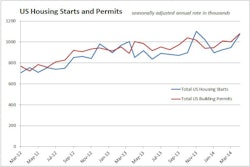Freddie Mac's March Multi-Indicator Market Index (MiMi) showed the U.S. housing market overall largely flat compared to the prior month. Of those markets that are improving or experiencing a stable range of housing activity, most are benefiting from the energy boom taking place along the country's mid-section.
Facts:
- The national MiMi value stands at -3.06 points indicating a weak housing market overall with only a slight improvement (+0.03 points) from February to March and a 3-month flat trend (+0.05 points). But the U.S. housing market has improved by 0.66 points since March of 2013. The nation's all-time MiMi low of -4.49 was in November 2010 when the housing market was at its weakest.
- Ten of the 50 states plus the District of Columbia are in their stable range with North Dakota, Wyoming, the District of Columbia, Alaska, and Louisiana ranking in the top five and unchanged from last month.
- Four of the 50 metro areas are in their stable range, San Antonio, New Orleans, Austin and Houston.
- The five most improving states month-over-month are Ohio (+0.12), Rhode Island (+0.11), Illinois (+0.10), Texas (+0.10) and South Carolina (+0.09). From one year ago the most improving states remained unchanged: Florida (+1.83), Nevada (+1.60), South Carolina (+0.99), California (+0.97) and Texas (+0.96).
- The five most improving metro areas month-over-month are Cincinnati (+0.11), Columbus (+0.11), Houston (+0.10), Riverside (+0.10), and San Antonio (+0.10). From one year ago the most improving metros remained unchanged: Miami (+2.37), Orlando (+1.91), Las Vegas (+1.71), Tampa (+1.57), and Riverside (+1.44).
- Overall, in March, 13 of the 50 states plus the District of Columbia are improving based on their three month trend, and 20 of the 50 metros show an improving trend.
"Less than half of the housing markets MiMi covers are showing an improving trend, whereas at this same time last year more than 90 percent of these same markets were headed in the right direction," said Freddie Mac Chief Economist Frank Nothaft?. "We're hopeful that many of these markets that have stalled will start moving again now that mortgage rates have eased over the past month and the spring home buying season is upon us."
MiMi monitors and measures the stability of the nation's housing market, as well as the housing markets of all 50 states, the District of Columbia, and the top 50 metro markets. MiMi combines proprietary Freddie Mac data with current local market data to assess where each single-family housing market is relative to its own long-term stable range by looking at home purchase applications, payment-to-income ratios (changes in home purchasing power based on house prices, mortgage rates and household income), proportion of on time mortgage payments in each market, and the local employment picture. The four indicators are combined to create a composite MiMi value for each market. Monthly, MiMi uses this data to show, at a glance, where each market stands relative to its own stable range of housing activity. MiMi also indicates how each market is trending, whether it is moving closer to, or further away from, its stable range. A market can fall outside its stable range by being too weak to generate enough demand for a well-balanced housing market or by overheating to an unsustainable level of activity.
For more detail on MiMi see the FAQs. MiMi is released at 10 a.m. EDT monthly [PDF]. The most current version can be found at FreddieMac.com/mimi.
Freddie Mac was established by Congress in 1970 to provide liquidity, stability and affordability to the nation's residential mortgage markets. Freddie Mac supports communities across the nation by providing mortgage capital to lenders. Today Freddie Mac is making home possible for one in four home borrowers and is one of the largest sources of financing for multifamily housing. Additional information is available at FreddieMac.com, Twitter @FreddieMac and Freddie Mac's blogFreddieMac.com/blog.



















